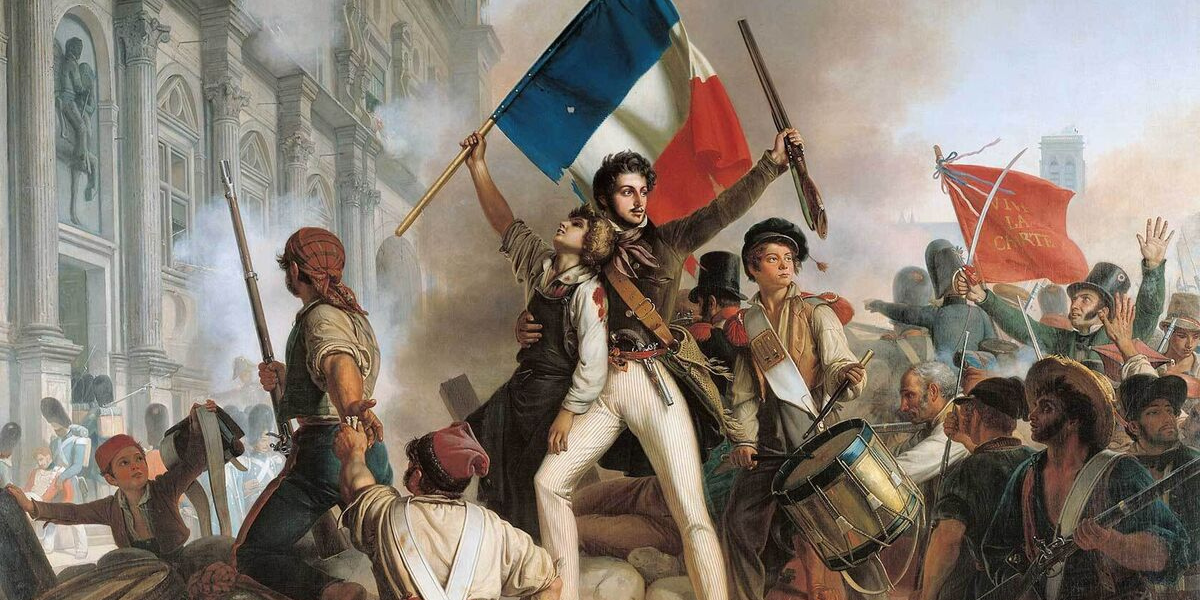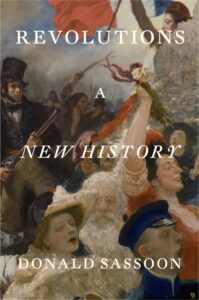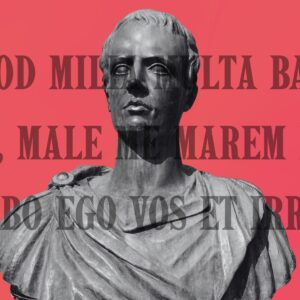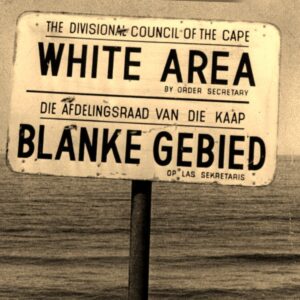
The Enduring Global Legacy of the French Revolution
Donald Sassoon Discusses How Years of Political Turmoil Resulted in the Advent of the Modern Era
Debate over the causes and consequences of the French Revolution has never abated. Complex events always have complex interpretations, and if they also have a political and ideological dimension, as is the case here, the difficulties multiply. The historian Albert Soboul began his 1965 account of 1789 as follows: “The Revolution marked the advent of bourgeois, capitalist society in the history of France”—adding that it was “the classic model of the bourgeois revolution.” Indeed in the West (and not only in the West), the start of the modern era is generally regarded as coinciding with the French Revolution.
But all ended well, with a monarch on the throne and everyone praying to God to save him or her.
Was it a bourgeois revolution, or a necessary factor in the development of capitalist society? France industrialized much later than Britain, the US, Belgium or even Germany, but earlier than most other countries. So, did the revolution make a difference? Was it inevitable? Did it accelerate change, removing obstacles to capitalism? If it had not occurred, would there not have been in any case an evolution towards a parliamentary republic—something like the Third Republic and its successors? Could the Orléans dynasty (1830–48) have evolved towards a relatively liberal parliamentary monarchy like the one in Britain? Such speculations can be amusing and interesting but, like much counterfactual history, they cannot be tested.
One should note, in passim, that while the French Revolution has remained a bone of political contention, this is not the case with the English Civil War, where disagreement has largely been confined to historians. The overthrow of Charles I would widely be seen as a “good thing” even if some might be a little perturbed by the execution of a king.
But all ended well, with a monarch on the throne and everyone praying to God to save him or her. In the US, meanwhile, there has always been virtual unanimity on the benefits of independence. The American Civil War, as we have seen, has remained a greater source of controversy.
In France, the dispute began almost immediately on whether the French Revolution was a good or a bad thing, or whether it started well and ended poorly. Could it have been better if it had finished in 1791–92, prior to the beginning of the Terror, or in 1795 when the worst of the Terror was over? Germaine de Staël’s Considerations on the Principal Events of the French Revolution, one of the earliest books on the French Revolution, praised 1789–91 but not what happened afterwards. De Staël was the daughter of Jacques Necker, finance minister under Louis XVI.
The modern revisionist view of the French Revolution started in the 1970s. Under the mantle of the Cold War, some French intellectuals with little sense of history described the Revolution as the beginning of “totalitarianism”—a term invented in Italy, first by anti-Fascists such as Giovanni Amendola (1923) and soon adopted, with positive connotations, by pro-Fascists such as the Italian philosopher Giovanni Gentile.
Hannah Arendt, in The Origins of Totalitarianism (1951), used it to describe both Nazi Germany and Stalin’s Russia (but not Italian Fascism; nor does she mention Giovanni Gentile). Some historians drew parallels between Georges Danton and Benito Mussolini, or Maximilien Robespierre and Vladimir Lenin. Totalitarianism was a trope for revisionist historians leading up to the bicentenary in 1989, which coincided with the fall of the Soviet Union and the massacre at Tiananmen Square in Beijing. Arno Mayer lamented in The Furies (2000) how “ultraconservative” historians had
argued that in addition to being an inexpiable sin, the French Revolution was the ultimate source of all the purgatorial fires of the twentieth century…They read the Jacobin Terror by the light of the Bolshevik Terror…and then went on to include the genocidal racism of the Third Reich.
François Furet’s Penser la Révolution française (1978) attempted to refute the Marxist presentation of the revolution as a bourgeois one. Furet had earlier co-produced a glossy two-volume study of the Revolution, La Révolution française (1965–66), described unkindly but not unjustly by Lynn Hunt as a coffee-table book.
Right-wing thinkers denounced what they regarded as the mindless violence of the revolutionary crowd.
Revisionism had been preceded by Alfred Cobban, whose 1954 inaugural lecture at University College London was published as The Myth of the French Revolution. Cobban was barely acknowledged by Furet and his colleagues. The main communist, socialist or marxisant historians against whom Furet wrote were Georges Lefebvre, author of La Grande Peur de 1789 (1932) and Quatre-vingt-neuf (1939), and above all Albert Soboul, who had written Les Sans-Culottes parisiens en l’An II (1958) and Histoire de la Révolution française (1962). An earlier leftist position had been delineated by Jean Jaurès in Histoire socialiste de la Révolution française (1901–07). Jaurès was a moderate socialist leader assassinated in 1914 for his opposition to the impending First World War.
Anti-revolutionary views of the French Revolution have a long lineage, including Chateaubriand’s Mémoires d’outre-tombe (started in 1809 and published posthumously in 1850), and Hippolyte Taine’s multivolume Origines de la France contemporaine (1875–1893). Members of Chateaubriand’s family had been executed in 1794. Right-wing thinkers denounced what they regarded as the mindless violence of the revolutionary crowd.
Gustave Le Bon’s Psychologie des foules (1895), largely based on the Italian Scipio Sighele’s La folla delinquente (1891), described how crowds were characterized by impulsivité and an absence de jugement et d’esprit critique commonly noted in such “inferior forms of evolution” as women, savages and children.
Pierre Gaxotte’s reactionary La Révolution française (1928) was described by historian of revolution Crane Brinton in the American Political Science Review as “not history.” Gaxotte’s extreme right-wing and anti-Semitic (but not pro-Nazi—he was a follower of the far-right Charles Maurras, founder of the Action Française) views did not prevent him writing regularly for Le Figaro and being elected in 1953 to the prestigious Académie française, where he fought against the election of women, panicking in 1980 that “if we elected a woman we would end up electing a negro.”
The economic history of the Directory, in the words of Denis Woronoff, is a “history of crises,” but as in all crises there were losers and winners. The losers, as always, were the poor.
In that year, the first woman to be elected, Marguerite Yourcenar, took her seat. Three years later, the Black poet and former president of Senegal Léopold Sédar Senghor was elected. By then Gaxotte was dead.
Louis XVI’s decision to convene the États Généraux (8 August 1788) launched a century of extraordinary instability in France. The country moved from absolute monarchy, as was still the case in June 1789, to a constitutional monarchy later that year. It then became a republic following the attack on the Tuileries, the royal residence, by the people of Paris on 10 August 1792. This was the beginning of what some have called the Second French Revolution. The radical republic was followed, in 1795, by the rule of the Directoire, a five-member committee. A new constitution was adopted which increased the powers of the more prosperous sectors of society. There was also a religious revival.
The economic history of the Directory, in the words of Denis Woronoff, is a “history of crises,” but as in all crises there were losers and winners. The losers, as always, were the poor. The winners came mainly from those already riches: landlords and wealthy farmers who had managed to accumulate some capital.
At first the new policies (liberal, in the economic sense) caused runaway inflation before the situation stabilized; by 1797, the economy was on the mend. But calm was far from being restored: there were plots from both monarchists and Jacobins. In 1796 came the famous Conspiracy of the Equals led by François-Noël “Gracchus” Babeuf, a proto-communist. It failed, and Babeuf was guillotined.
There were wars in Europe. By the end of 1798, Allied armies (British, Austrian and Russian) were marching once more against France. At first the French suffered defeats, discrediting the Directory. It was during this period of turmoil that the army, inevitably, became a political force. This was the key factor in the rise of its general, Napoleon Bonaparte, to power.
On November 9, 1799 (18 Brumaire) the République bourgeoisie was overthrown in a military coup led by Napoleon, who made himself consul for life in 1802, and emperor in 1804. The republic hadn’t been well entrenched, hence its weakness. An official report in April 1799 had concluded that only eight departments could be considered reliably republican: Creuse, Meurthe, Haute-Saone, Hautes-Pyrenees, Finistère, Jura, Haute-Garonne and Pyrenees-Orientales.
In mid-1793, writes Arno Mayer, “some sixty of France’s eighty-three departments were more or less out of control and a majority of the population in various degrees” was unfavorable to a republic. The French Revolution, though centred on Paris, differed from region to region.
The monarchists were still powerful, but by 1880 the new republic was well established. Only then could one say that the French Revolution was definitively over.
The period of almost continuous wars that had started in 1792 came to a close in 1815 at Waterloo, having been preceded by constant warfare for most of the eighteenth century. The restoration of the Bourbon dynasty in 1814 was followed by the so-called revolution of 1830, which put the Orléans dynasty in power with Louis-Philippe I, now more democratically known as king of the French, rather than king of France. He was to be the last French king.
Between 1799 and 1847 the French wrote six constitutions, none of which defined where political authority resided, unlike the previous three which had declared that power resided with the nation (1791), “the people” (1793) and “all citizens” (1795).
In 1848 another revolution established a short-lived Second Republic, which led to a coup d’état by Louis Napoleon, who had been elected president. In 1852, following in the footsteps of his uncle, he too became emperor, as Napoleon III. This Second Empire crumbled when it was defeated by the Prussians in the war of 1870.
Out of this defeat the Third Republic was born, threatened by an attempt to establish a radical polity (the Paris Commune). The monarchists were still powerful, but by 1880 the new republic was well established. Only then could one say that the French Revolution was definitively over.
The constant change of regimes signaled that the French Revolution was not an event which could be encapsulated in the few years following the seizure of the Bastille. The best French minds had understood this clearly. In his recollection about 1848, Tocqueville wrote:
The constitutional monarchy succeeded the Ancient Régime. The Republic succeeded the monarchy. The Empire succeeded the Republic. The Restoration succeeded the Empire. Then came the July Monarchy. After each of these successive transformations people said that the French Revolution, having completed what they presumptuously called its work, was over. They said it and believed it. Alas! I had myself hoped it was true during the Restoration and again after the government fell. And now the French Revolution has begun anew, for it remains the same revolution as before. The farther we go, the more obscure its end becomes.
Albert Laponneraye, a proto-communist journalist and activist, editor of Robespierre’s works, was not wrong when he wrote in the 1830s: “The Revolution is still continuing and will only be concluded when the kings will have exterminated the people or the people will have exterminated the kings.” Laponneraye died in 1849, just as Louis Napoleon was about to consolidate his power.
To write, as some do, that the French Revolution occurred between May 1789, when the king convened the États Généraux, and 27 July 1794 (9 Thermidor, Year II), when the moderates took over—or else ended on 9 November 1799 (18 Brumaire Year VIII), when Bonaparte seized power—is to disregard this century of strife.
At least until 1917, the French Revolution was the revolution. It had embraced universal values in a way that would have been unthinkable in seventeenth-century England, although the American War of Independence had anticipated it in this respect.
Thomas Paine wrote in Common Sense (1776): “The cause of America is in a great measure the cause of all mankind.” His letter to George Washington announced a present from “Our very good Friend the Marquis de la Fayette,” namely “the Key of the Bastile [sic],” with a drawing “representing the demolition of that detestible [sic] prison,” and described such gifts as the “first ripe fruits of American principles transplanted into Europe.”
The sentiments expressed in the Declaration of Independence were incorporated in the Declaration of the Rights of Man and of the Citizen of 1789. But it was the French Revolution that became the revolution par excellence. Much to her chagrin, and with some exaggeration, Hannah Arendt wrote: “The sad truth of the matter is that the French Revolution, which ended in disaster, has made world history, while the American Revolution, so triumphantly successful, has remained an event of little more than local importance.”
The French Revolution was, in Immanuel Wallerstein’s words, “a world-historical event.” For Eric Hobsbawm, it was “a landmark” which set the pattern “for all subsequent revolutionary movements,” including socialist and communist ones. It provided a pattern for modern politics more widely, as Lynn Hunt has noted, by creating “parties, ideologies, dictators, mass movements.”
The French Revolution is celebrated in endless novels, plays and films, and not just in France.
Engels, writing in 1847, took a different position. Objecting to a note of French exceptionalism in a speech by the socialist reformer and historian Louis Blanc, he contrarily observed: “Without intending to deprecate in any manner the heroic efforts of the French Revolution, and the immense gratitude the world owes to the great men of the Republic,” the English Industrial Revolution was far more cosmopolitan, since “England invented the steam-engine; England erected the railway; two things which, we believe, are worth a good many ideas.” Furthermore, “as far as ideas are concerned…let us never forget Milton, the first defender of regicide, Algernon Sydney, Bolingbroke, and Shaftesbury, over their French more brilliant followers.”
Yet there is no doubting the subsequent global popularity of the French Revolution symbolized by the reverence for the French flag in European progressive and nationalist circles. A tricolor was widely adopted, with changing colors, by nationalists in Italy and Germany, but also in Belgium, Hungary and even in distant Mexico. There were hardly any national flags previously. The first was what was later called the Stars and Stripes, created on June 14, 1777 at the Second Continental Congress. It consisted of thirteen stripes and thirteen stars representing the thirteen American colonies.
The French Revolution is celebrated in endless novels, plays and films, and not just in France. Songs connected to the revolution have had a global reach, above all with “La Marseillaise,” which was sang by anarchists accused of taking part in the Haymarket affair in Chicago in 1886 on their way to the gallows. It was later performed by military bands in Moscow and Petrograd to celebrate the downfall of the tsar. There were other revolutionary songs even more blood-curdling, such as “Ah ça ira” (It will be all right, or Let’s do it).
Ah! ça ira, ça ira, ça ira
les aristocrates à la lanterne!
Ah! ça ira, ça ira, ça ira
les aristocrates on les pendra!
Si on n’ les pend pas
On les rompra
Si on n’ les rompt pas
On les brûlera.
Ah! Let’s do it, Let’s do it, Let’s do it, aristocrats to the lamp-post!
Ah! Let’s do it, Let’s do it, Let’s do it, the aristocrats, we’ll hang them!
If we don’t hang them
We’ll break them
If we don’t break them
We’ll burn them.
“La Carmagnole” mocks Louis XVI (as Monsieur Veto) and Marie Antoinette (Madame Veto):
Madame Veto avait promis, de faire égorger tout Paris,
Mais son coup a manqué grâce à nos canonniers
Dansons la Carmagnole,
Vive le son du canon.
Madame Veto had promised to cut all the throats in Paris,
But she failed thanks to our gunners.
Let us dance the Carmagnole.
Long live the sound of guns.
The English Civil War, by comparison, generated very little in terms of popular musical culture. There is “Stand Up Now, Diggers All!” written by Gerrard Winstanley (“But the Gentry must come down, and the poor shall wear the crown”), but few know how to sing it.
The best-known Scottish political song, “The Skye Boat Song,” is about the return of Charles Stuart (Bonnie Prince Charlie), the Jacobite rebellion of 1745 and the defeat at Culloden. It was written in the late nineteenth century by an Englishman and was far from revolutionary. Most of the best-known American political songs of the nineteenth century come from the Civil War, such as the famous “Battle Hymn of the Republic” based on the music of the abolitionist song “John Brown’s Body.”
France made revolutions, but, after the failures of the Napoleonic Wars, never tried to export them; it became a real bourgeois country.
Hardly any are connected to the War of Independence, except “Yankee Doodle Dandy.” The lyrics of the best-known version of “Yankee Doodle Dandy” are apolitical and were originally composed and sung by the English to make fun of disheveled and disorganized colonials. The latter turned it into a song of defiance around 1781.
The English Revolution was not exported. English troops did not try to impose the new system on anyone, though they did undertake a bloody reconquest of Ireland. However, British ideas were exported, or rather imported, by reformers and revolutionaries. Locke was widely read by French intellectuals, such as Montesquieu and Diderot. Voltaire, in his bestselling Letters on England (1734), wrote admiringly about the British system and English “freedoms.” In 1789 France, Adam Smith’s Wealth of Nations (1776) was regarded as “supportive of constitutional innovation.”
English “freedoms” and “moderation” were often invoked during the debates of August and September 1789, when the rights of citizens were being discussed. Bertrand Barère, president of the National Convention in November–December 1792, believed that the English model of a constitutional monarchy was suitable for France. But by 1794 he was denouncing the English, whom he had come to regard as under the thumbs of despots and bankers, declaring that French was the only republican language.
The global renown of the French Revolution was also enhanced by the formidable role played by French culture and the French language throughout the nineteenth century. America, by contrast, was a distant prospect, which, in the European mind, had barely progressed from “My America, my new-found-land,” as John Donne had intoned in his poem “To His Mistress Going to Bed” (1582). France made revolutions, but, after the failures of the Napoleonic Wars, never tried to export them; it became a real bourgeois country. Its aristocrats remained ensconced in the bureaucracy and the military, while Britain became a country of bankers and mill owners pretending to be aristocrats.
__________________________________

From Revolutions: A New History. Used with the permission of the publisher, Verso Books. Copyright © 2025 by Donald Sassoon.
Donald Sassoon
Donald Sassoon was born in Cairo in 1946. He taught comparative European history at Queen Mary University of London for many years. His books include Morbid Symptoms, The Anxious Triumph, The Culture of the Europeans, One Hundred Years of Socialism and Mona Lisa, all widely translated. He lives in London.












